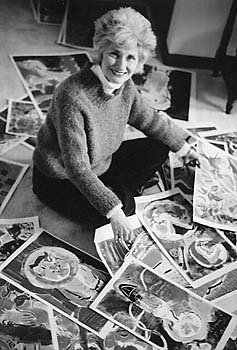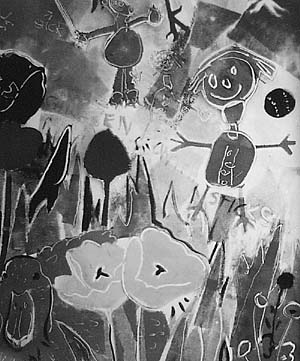
 |
Summer 2003 |
|
An interview with Denise Giardina ADA: Becoming Accessible From the Director A convergence of printmakers and potters Monoprints of Barbara Marsh Wilson Interview with Mark Wolfe |
An art of experience
|
 Artist Barbara Marsh Wilson surrounded by some of her prints. |
Wilson had clearly had an eventful year. The crowd of animals, birds, insects and flowers was amazing. Some of the adventures and misadventures the prints depicted were daunting. “This is the experience I had one year,” said Wilson, taking me into the kitchen. “A duck built its nest near my home. I was so worried about that duck all summer.” The epic consists of four panels side by side with script woven throughout the piece. The protagonist, a blue mother duck with a determined and brilliant bill, moves valiantly through all four pieces. The artist narrated: “Panel one, Never Build Your Nest Next to a Condo. Never Build Your Nest Where Cats Are Walking. Cats walked by this poor duck all day and I was always watching, making sure they didn’t scare it off or kill it. And we had kids living nearby, so, two, Never Where Balls Are Flying. The balls would come and almost hit the nest; the duck would be running off. Three, Never Where Kids Are Playing With Sticks. It was so nerve-wracking. The duck was trying her best to hatch her eggs all summer and if that wasn’t enough, she had to worry about the landlord coming out and spraying for bugs, Never Where the Landlord is Spraying for Bugs. She had a hard life, but the eggs finally hatched.” |
Wilson says that if an experience is wonderful (by that I believe she means wonder-filled), she loves the piece even if no one else does. This piece, she vowed, would never leave her possession.
Another piece in the kitchen was a how-to triptych. “This is an experience I had last spring. I wanted a brick patio. I had the bricks delivered and decided to do it myself. I had a friend take pictures of my building it. The piece is in three parts: one, Spreading the Sand, two, Laying the Bricks and Making the Pattern, and three, Enjoying the Patio with a Friend.”
In the first part, a gloved hand out of proportion to the figure extends from the picture into the viewer’s space to grab another brick. “I love space contradictions in my work,” Wilson laughed, “and I try to tie each part together using the same elements, line and color. The final result: a snack on the patio. I just wanted to portray a wonderful experience of building a brick patio.”
I believe I could make a brick patio after seeing this piece. Wilson has two other how-to triptychs: a mouth watering Lemon Meringue Pie Recipe and a nostalgic Mother’s Apple Pie Recipe, which won the D. Gene Jordon Award in the 1993 West Virginia Juried Exhibition at the Cultural Center.
Wilson is a formidable draftsman. I asked her if she remembers drawing as a child. “For as long as I can remember,” she sighed.
 |
 |
Two monoprints from the series Never Build Your
Nest Next to a Condo.
Left: “Never Build Your Nest Where Cats Are
Walking.”
Right: “Never Build Your Nest Where Children Are Playing with
Sticks.”
Wilson grew up close to Hurricane, where she lives now. Her earliest memory is from the age of four. “I remember, I drew these brides on the blackboard and I kept experimenting with line until I had a profile of a person holding a bouquet. And I remember everything about that experience and finding out that if I kept at it long enough I could make it look like a bride.
“Then a terrible thing happened. My mother brought home a coloring book and I started copying the pictures out of the coloring book. I got to where I could copy them exactly. So then, I learned what a tree really looks like, what a horse really looks like, and I became a realist. I went all through grade school and high school doing well in art as a realist, copying things better than anyone else. I even went through graduate school copying.”
After being out of school for some time, Wilson began to feel that her work was not creative. She saw a retrospective of the great French colorist Henri Matisse and began to feel that her work could be more personal, more expressive. Thinking a change of artistic medium could help, she enrolled in a lithography class. In 1980 she saw a monoprinting demonstration. She began to experiment with that procedure, blocking out areas and playing with color and shape.
The process brought back a realization she’d come to in graduate school when she’d taken a course in aesthetic experience. That class encouraged her to explore all the senses and to keep a journal recording the sensations, feelings and perceptions that everyday encounters produced.
“I recorded different things in my life, like seeing one red leaf on a tree of green leaves, and what that did to me; how it felt to touch a certain thing; driving through trees with overlapping boughs. Tasting. Lemonade. Every now and then you get a piece of pulp and it explodes with sourness in your mouth. I thought at the time that a person’s aesthetic experience could be the content of a their art.”
She continued making monoprints. “I started using my experiences as the content and printing on the press as the form, and that’s the way I’ve been creating my art ever since. You could spend a lifetime on your sensory experiences. That’s the content for a lifetime, and that’s what I’m doing.”
Easier said than done. First Wilson makes a detailed drawing. She then draws and cuts stencils which she uses to ink up the plate. Each shape has its own stencil and Wilson says the process can be tiresome. “I spend a lot of time looking for the right stencil.” Sometimes she writes text into the plate or draws in details that will show up white on the finished print.
The procedure up to this point is exacting, but then “the magic happens.” The inked plate and paper, sandwiched between layers of felt, goes through the press and the printed image is born.
“After I pull the print and it dries, I sometimes go back into it with watercolor. Sometimes I don’t have to; they come off the press just like I want. But many times I go back and add the transparency, and it adds another dimension.”
Wilson sits amid her prints like a diminutive wizard. Her “sensory experiences” are extraordinary glimpses: Blue jays sunning, ducks feeding, insects singing, cats lounging. She interprets these as grand happenings and pulls the viewer into the print to luxuriate in the abstract complexities she creates. The inks are heavily saturated and create a velvety, hypnotic color. Wilson combines those colors with an audacity that would make Kandinsky blush. Her sure drawing supports the respect she has for each detail and the well-loved characters she attracts. For this viewer, her subjects are the great unknowns, origins and endings but for Barbara Marsh Wilson, well, it’s just what happened to her one time.
Barbara Marsh Wilson joins printmakers Mary Grassell, Jan Griffin and Peter Massing and potters Louise Lamar-Fuller and Bozina Plucinska in the Stifel Fine Arts Center show Collective Impressions until July 26.